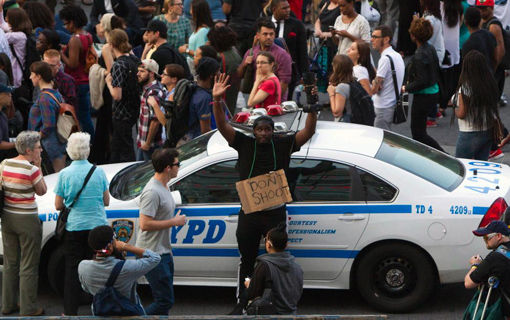
STATEN ISLAND, N.Y.-Thousands of people turned out Aug. 23 to protest police officers’ July 17 smothering – officially ruled a homicide – of Eric Garner, an unarmed African American man, as well as a spate of other killings by police around the country.
The marchers, from all five New York City boroughs, called for reforms in the process of disciplining police officers who use unlawful force, and in police officer training. They demanded jail time for Daniel Pantaleo, the officer who allegedly killed Garner with a choke hold.
Staten Island is not known for large demonstrations or progressive politics. Nonetheless, the majority of those who marched were from the island.
“There would have been more people from the [Latino] community,” said Inez Gonzalez, who marched carrying a sign bearing the name of Make the Road New York, a local organization focused on immigrant and LGBTQ rights. “But a lot of people…who have had problems with the police – all I’ll say is that it’s an extra burden, to be seen by the police.” Indeed, northern Staten Island has a significant undocumented Hispanic population. “This affects us, too,” Gonzalez continued, “police on the run; but for some of us, it’s too risky.”
Nonetheless, Latinos made up a large portion of the march. This coming together of Black and Latino is meaningful given the history of strife between the two communities, culminating in several violent incidents in 2010. Taking note of the unity and diversity of the crowd, the Rev. Al Sharpton, who initially called the march, said during the closing rally, “Blacks, whites, Latinos, Asians: We all came down Bay Street together, we can change the world together.”
From Bay St. and Victory Ave., the march continued into the rapidly gentrifying Saint George neighborhood, the bay for which the street is named and Manhattan’s majestic skyline in the background, on to the office of Staten Island district attorney Daniel Donovan, Jr.. Donovan has summoned a grand jury to decide whether to bring charges against Pantaleo. The protesters demanded that someone else lead the prosecution, suspecting that Donovan will let the officer off with a slap on the wrist.
Demonstrations will continue “until someone goes to jail,” former New York Gov. David Paterson, a Democrat, told the crowd. Paterson listed more than a dozen deaths of innocent people at the hands of the NYPD in recent decades. The mothers of some of these victims, including Amadou Diallo’s, joined Paterson on stage.
“Hands up, don’t shoot,” demonstrators chanted, holding their hands in the air as they marched past the Tompkinsville neighborhood spot where Garner was killed. The chant referred to police shootings of unarmed people, especially African Americans, sometimes with their hands up, sometimes in the back.
The former was the case for Michael Brown, whose August 9 shooting sparked the ongoing outpouring of anger in Ferguson, Mo. The latter is allegedly the case on August 11 in Los Angeles, where officers shot Ezell Ford. Like Garner and Brown, Ford was African American and unarmed: According to witnesses, he was complying with police, lying face down on the ground, and shot in the back. Ford’s attorney has referred to the shooting as “an execution.”
Sharpton, Paterson, and nearly all other speakers emphasized that the rally was not anti-police, only anti-police brutality. Sharpton even thanked police on duty that day for logistical help. This did not keep the New York Post and other media, however, from referring to the rally as “anti-NYPD.” The same media also created tension by spreading rumors that the rally would turn violent.
It didn’t; not a single arrest was made.
Staten Island residents have kept a vigil where Garner’s death occurred, moved both by feelings of sympathy for Garner and his children, as well as simmering anger at the way police behave in the area. The New York Times has cited the two north shore neighborhood precincts with a far higher rate of aggression than the city average. Residents, mostly Black and Latino, also express frustration at other police tactics. “Stop and frisk is supposedly over,” said a demonstrator, “but what do you call it when the police pull over your car and demand to see your license and registration and insurance – all because you [were] in the area?”
Aside from Sharpton’s National Action Network, organizations at the march included the NAACP, the United Federation of Teachers, the Working Families Party, SEIU 1199, churches, immigrant rights groups, and others.
Photo: A cameraman in New York City protests unlawful force, especially the Ferguson shooting. Michael R. Sisak/AP

MOST POPULAR TODAY

High Court essentially bans demonstrations, freedom of assembly in Deep South

U.S. imperialism’s ‘ironclad’ support for Israel increases fascist danger at home

Zionist organizations leading campaign to stop ceasefire resolutions in D.C. area

Resource wars rage in eastern Congo, but U.S. capitalism only sees investment opportunity







Comments